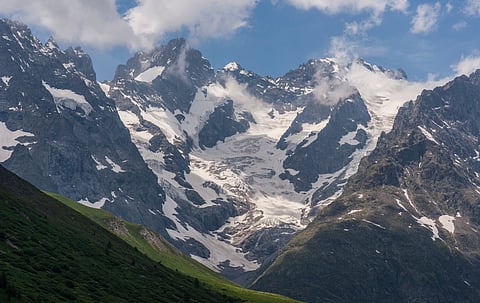
- Destinations
- Experiences
- Stay
- What's new
- Celebrating People
- Responsible Tourism
- CampaignsCampaigns
- SubscribeSubscribe
- Buy Now

With the just concluded Paris Olympics 2024, we totally understand if your thirst for sporting events and French culture continues. If you are a nature lover who wants to explore the country’s wild beauty, then you should check out the unspoilt environment and leisure activities found in the country’s national parks. These 11 areas—along with a host of regional parks and nature reserves—welcome over 9 million people every year.
As free spaces open to all, France's national parks are perfect for practising your favourite activities in a protected, awe-inspiring setting—whether you engage in hiking, swimming, diving, paragliding or winter sports. Here’s our selection of seven of the best.
Situated between the Tarentaise and Maurienne valleys in the French Alps is Vanoise National Park, France’s first national park when it was created in 1963. The park is well known for its population of Alpine ibex. The Alpine marmot, wolves, Eurasian lynx, mountain hares, Eurasian badger, ermine, weasel, Alpine chamois, bearded vulture, golden eagles, Eurasian eagle-owl, black woodpeckers, nutcrackers and black grouses can be found here. The park is bordered by several large French ski resorts like Les Trois Vallées, Tignes, Val-d'Isère, Les Arcs and La Plagne, which get throngs of tourists in the winter. Hiking and mountain biking are popular activities in the summer.
This coastal archipelago in the Mediterranean Sea is among the oldest of French national parks and the country's first marine park. The protected area measures about 1,700 hectares on land and 2,900 hectares at sea, 600m from the coast. Most of the area of the main islands of Port-Cros and Porquerolles are protected, as well as the small islands of Bagaud, Gabinière and Rascas. Lightly wooded and sparsely populated, the islands are brilliant for exploring by cycle or on foot. The abundance of small beaches and coves are fantastic for snorkelling and diving trips.
With peaks rising to over 3,000m, an abundance of waterfalls and mountain torrents, 230 high-altitude lakes, and vast areas of forest, the Pyrénées National Park in France has a stunning concentration of natural riches. It stretches for 100km east to west from the Aure to the Aspe Valley. In an area covering some 50,000 hectares along the Spanish border stand the giant cirques at Gavarnie and Troumouse, the impressive Vignemale massif, and the Pic de Néouvielle. The park is home to some 6,000 chamois, masses of marmots and birds of prey such as the bearded vulture, the golden eagle and the peregrine falcon. If you want to see traditional mountain life then this is the right place.
This national park is located in southern France, in the mountainous area of Cévennes. Here you will find the granite highlands of Mont Lozère, the majestic forests of the Aigoual and the vast limestone plateaus of the Causse Méjean, notched by the spectacular Tarn and Jonte gorges. Heavily wooded with old-growth oak, beech and sweet chestnut, the Cévennes mountain range is an important biodiversity area and was recognised as a Unesco Biosphere Reserve; some 2,300 plants and 2,410 animals have been recorded here. It’s a popular area for canoeing, rafting and trekking. Check out the underground Causses et Cévennes, which has some of France’s most extensive cave systems, while you’re here.
Écrins National Park sits in the southeastern part of France, in the Dauphiné Alps south of Grenoble and north of Gap. More than 100 peaks sit within its borders, including France’s second-highest summit, the Barre des Écrins at 4,102m. The park is rich in geographical diversity with high mountain areas, glacier fields, glacier valleys, alpine pastures, subalpine woodlands and lakes keeping one another company. Some 700km of marked trails wind their way around the park, many of which have been trodden by local shepherds for centuries. There are plenty of treks you can take advantage of at this national park such as the Glacier Blanc and the summit of Barre des Écrins.
This national park is located in the Alpes-de-Haute-Provence and Alpes-Maritimes departments. The protected area covers some 679 square kilometres and houses spiky peaks, steep valleys, remote mountain villages and a handful of glaciers. Blanketed by snow in winter, the park basks in Provençal sunlight from around May to September, making it just right for summer hiking. Mouflons, chamois, ibex, golden eagles and rare bearded vultures can be seen here. Don’t miss a visit to the Vallée des Merveilles, where over 36,000 ancient stone carvings are engraved into the rocks.
Calanques National Park is on the Mediterranean coast in Bouches-du-Rhône. It consists of an area of high, rugged cliffs that extend southeast from Marseille. The network of steep-sided canyons have been carved out over millennia by weather, geology and time. There are lots of stunning coves that will capture your heart here but the main attractions are the ones named Calanque d’En Vau, Port-Miou, Port-Pin and Calanque de Morgiou.
